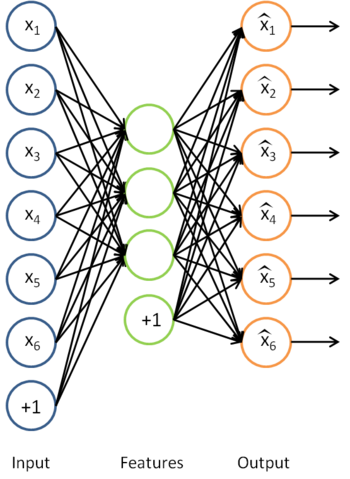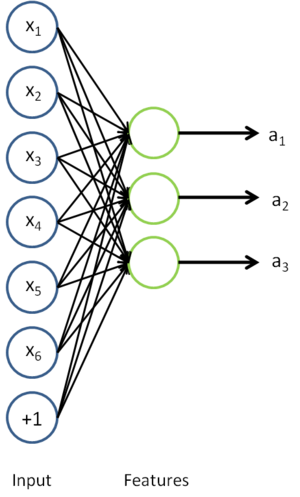Self-Taught Learning
the promise of self-taught learning and unsupervised feature learning is that if we can get our algorithms to learn from unlabeled data, then we can easily obtain and learn from massive amounts of it.Even though a single unlabeled example is less informative than a single labeled example, if we can get tons of the former---for example, by downloading random unlabeled images/audio clips/text documents off the internet---and if our algorithms can exploit this unlabeled data effectively, then we might be able to achieve better performance than the massive hand-engineering and massive hand-labeling approaches.
Learning features
We have already seen how an autoencoder can be used to learn features from unlabeled data. Concretely, suppose we have an unlabeled training set
with
unlabeled examples. (The subscript "u" stands for "unlabeled.") We can then train a sparse autoencoder on this data (perhaps with appropriate whitening or other pre-processing):
Having trained the parameters
of this model, given any new input
, we can now compute the corresponding vector of activations
of the hidden units. As we saw previously, this often gives a better representation of the input than the original raw input
. We can also visualize the algorithm for computing the features/activations
as the following neural network:
This is just the sparse autoencoder that we previously had, with with the final layer removed.
Now, suppose we have a labeled training set
of
examples. (The subscript "l" stands for "labeled.") We can now find a better representation for the inputs. In particular, rather than representing the first training example as
, we can feed
as the input to our autoencoder, and obtain the corresponding vector of activations
. To represent this example, we can either just replace the original feature vector with
. Alternatively, we can concatenate the two feature vectors together, getting a representation
.
Thus, our training set now becomes
(if we use the replacement representation, and use
to represent the
-th training example), or
(if we use the concatenated representation). In practice, the concatenated representation often works better; but for memory or computation representations, we will sometimes use the replacement representation as well.
Finally, we can train a supervised learning algorithm such as an SVM, logistic regression, etc. to obtain a function that makes predictions on the
values. Given a test example
, we would then follow the same procedure: For feed it to the autoencoder to get
. Then, feed either
or
to the trained classifier to get a prediction.
On pre-processing the data
During the feature learning stage where we were learning from the unlabeled training set
, we may have computed various pre-processing parameters. For example, one may have computed a mean value of the data and subtracted off this mean to perform mean normalization, or used PCA to compute a matrix
to represent the data as
(or used PCA whitening or ZCA whitening). If this is the case, then it is important to save away these preprocessing parameters, and to use the same parameters during the labeled training phase and the test phase, so as to make sure we are always transforming the data the same way to feed into the autoencoder. In particular, if we have computed a matrix
using the unlabeled data and PCA, we should keep the same matrix
and use it to preprocess the labeled examples and the test data. We should not re-estimate a different
matrix (or data mean for mean normalization, etc.) using the labeled training set, since that might result in a dramatically different pre-processing transformation, which would make the input distribution to the autoencoder very different from what it was actually trained on.
On the terminology of unsupervised feature learning
There are two common unsupervised feature learning settings, depending on what type of unlabeled data you have. The more general and powerful setting is the self-taught learning setting, which does not assume that your unlabeled data xu has to be drawn from the same distribution as your labeled data xl. The more restrictive setting where the unlabeled data comes from exactly the same distribution as the labeled data is sometimes called the semi-supervised learning setting. This distinctions is best explained with an example, which we now give.
Suppose your goal is a computer vision task where you'd like to distinguish between images of cars and images of motorcycles; so, each labeled example in your training set is either an image of a car or an image of a motorcycle. Where can we get lots of unlabeled data? The easiest way would be to obtain some random collection of images, perhaps downloaded off the internet. We could then train the autoencoder on this large collection of images, and obtain useful features from them. Because here the unlabeled data is drawn from a different distribution than the labeled data (i.e., perhaps some of our unlabeled images may contain cars/motorcycles, but not every image downloaded is either a car or a motorcycle), we call this self-taught learning.
In contrast, if we happen to have lots of unlabeled images lying around that are all images of either a car or a motorcycle, but where the data is just missing its label (so you don't know which ones are cars, and which ones are motorcycles), then we could use this form of unlabeled data to learn the features. This setting---where each unlabeled example is drawn from the same distribution as your labeled examples---is sometimes called the semi-supervised setting. In practice, we often do not have this sort of unlabeled data (where would you get a database of images where every image is either a car or a motorcycle, but just missing its label?), and so in the context of learning features from unlabeled data, the self-taught learning setting is more broadly applicable.
自学习 VS 半监督学习
半监督学习假设,未标记数据和已标记数据拥有相同的数据分布
Self-Taught Learning的更多相关文章
- 一个Self Taught Learning的简单例子
idea: Concretely, for each example in the the labeled training dataset xl, we forward propagate the ...
- The Brain vs Deep Learning Part I: Computational Complexity — Or Why the Singularity Is Nowhere Near
The Brain vs Deep Learning Part I: Computational Complexity — Or Why the Singularity Is Nowhere Near ...
- What is machine learning?
What is machine learning? One area of technology that is helping improve the services that we use on ...
- How do I learn machine learning?
https://www.quora.com/How-do-I-learn-machine-learning-1?redirected_qid=6578644 How Can I Learn X? ...
- (转) Ensemble Methods for Deep Learning Neural Networks to Reduce Variance and Improve Performance
Ensemble Methods for Deep Learning Neural Networks to Reduce Variance and Improve Performance 2018-1 ...
- A Brief Overview of Deep Learning
A Brief Overview of Deep Learning (This is a guest post by Ilya Sutskever on the intuition behind de ...
- 5 Techniques To Understand Machine Learning Algorithms Without the Background in Mathematics
5 Techniques To Understand Machine Learning Algorithms Without the Background in Mathematics Where d ...
- 深度学习Deep learning
In the last chapter we learned that deep neural networks are often much harder to train than shallow ...
- 【转】The most comprehensive Data Science learning plan for 2017
I joined Analytics Vidhya as an intern last summer. I had no clue what was in store for me. I had be ...
- Neural Networks and Deep Learning
Neural Networks and Deep Learning This is the first course of the deep learning specialization at Co ...
随机推荐
- YYDispatchQueuePool阅读笔记
阅读了开源大神的YYDispatchQueuePool,在此记下一些从中学到的东西. 首先YYDispatchQueuePool.m文件中有如下类型对应: static inline dispatch ...
- java中移位操作
/** * * @author SunRain *2013-10-14 8:09:50 *在最后一个移位运算中,结果没有直接付给b,而是直接打印出来,所以结果是正确的, *其他的是会被先转换成int型 ...
- caffe(3) 视觉层及参数
本文只讲解视觉层(Vision Layers)的参数,视觉层包括Convolution, Pooling, Local Response Normalization (LRN)局部相应归一化, im2 ...
- Python3 利用POP3与smtplib进行计算机远程控制
初习,代码有不足之处,欢迎指出. 跟大家分享的是,通过发送端发送cmd命令,从而对接收端进行cmd命令的控制. #接收端代码 from poplib import POP3 import time,o ...
- 【DevExpress】GridControl添加按钮列并添加按钮事件
在GridControl中添加按钮列的步骤如下: 1. 把列的ColumnEdit属性设置为RepositoryItemButtonEdit 2. 把TextEditStyle属性设置为HideTex ...
- ArcGIS api for javascript——地图配置-定制缩放动画
描述 本例展示了当用户放大或缩小地图时如何定义地图的动画.zoomDuration和zoomRate是Dojo动画属性,他们确定了动画的duration和帧刷新的rate .这些属性单位是毫秒,zoo ...
- XMPP使用简单介绍--登录
在现阶段的通信服务中,各种标准都有.因此会出现无法实现相互连通,而XMPP(Extensible Message and presence Protocol)协议的出现,实现了整个及时通信服务协议的互 ...
- POJ 3263 差分+set判重
题意: 思路: 对于每一个区间 [a,b] [a+1,b-1]肯定是比a,b低至少1的 因为题目要求最大值 所以就直接差分一下 搞之 (复杂度 O(n)) Discuss里说有重复的数据 用set判一 ...
- 初学PHP&MySQL 2014-05-31 12:40 92人阅读 评论(0) 收藏
PHP echo print 都能输出文本 date(format,timestamp)可以格式化时间戳 mktime()可以返回指定日期的时间戳 include 'filename'或者 requ ...
- hbase启动报错:Java HotSpot(TM) 64-Bit Server VM warning: ignoring option PermSize=128m; support was removed in 8.0
输入HBASE_MASTER_OPTS只是为了快速寻找这个选项而已,如果你手工找也可以 刚才那个命令回车后直接跳到这 前面加#就好了 修改后保存.重新启动hbase就好了. 注意:各个节点都要修改哦. ...


